HRM Approaches: Analyzing Soft and Hard Human Resource Management
VerifiedAdded on 2023/01/18
|11
|3740
|92
Report
AI Summary
This report provides a comprehensive analysis of soft and hard approaches to Human Resource Management (HRM). It begins by defining and explaining both concepts, highlighting their core principles and objectives. The report delves into the specifics of hard HRM, emphasizing its focus on cost control, autocratic leadership, and treating employees as resources to maximize profitability. It then contrasts this with soft HRM, which prioritizes employee well-being, motivation, and long-term workforce planning through democratic leadership and employee involvement. The report uses Tesco as a case study, illustrating how soft HRM practices, such as skill development programs and a focus on employee needs, can foster a positive work environment and improve employee retention. It also acknowledges potential disadvantages of soft HRM, such as slower decision-making processes. Overall, the report offers a comparative perspective on these two HRM approaches, examining their implications for organizational effectiveness, employee satisfaction, and competitive advantage.
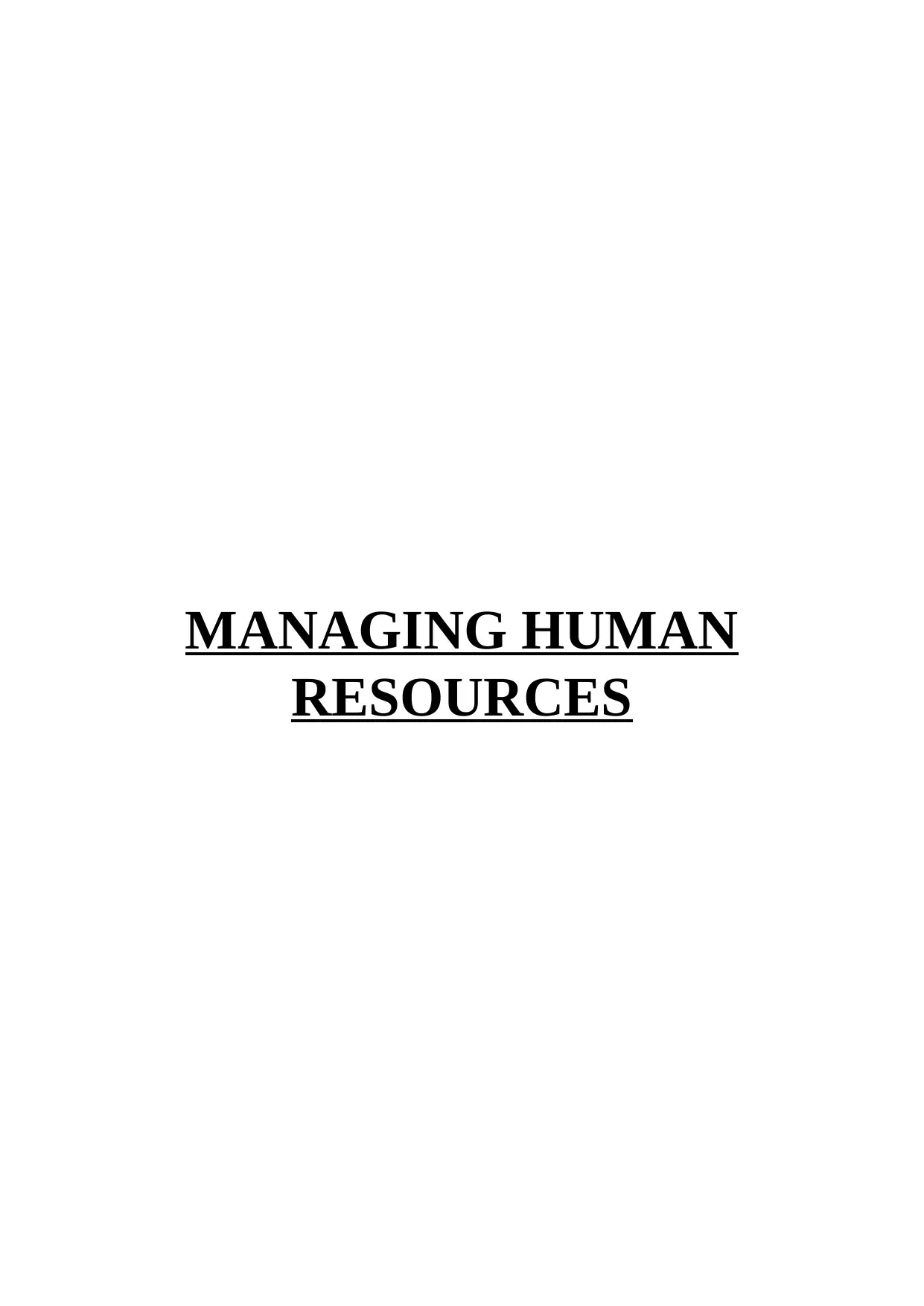
MANAGING HUMAN
RESOURCES
RESOURCES
Paraphrase This Document
Need a fresh take? Get an instant paraphrase of this document with our AI Paraphraser
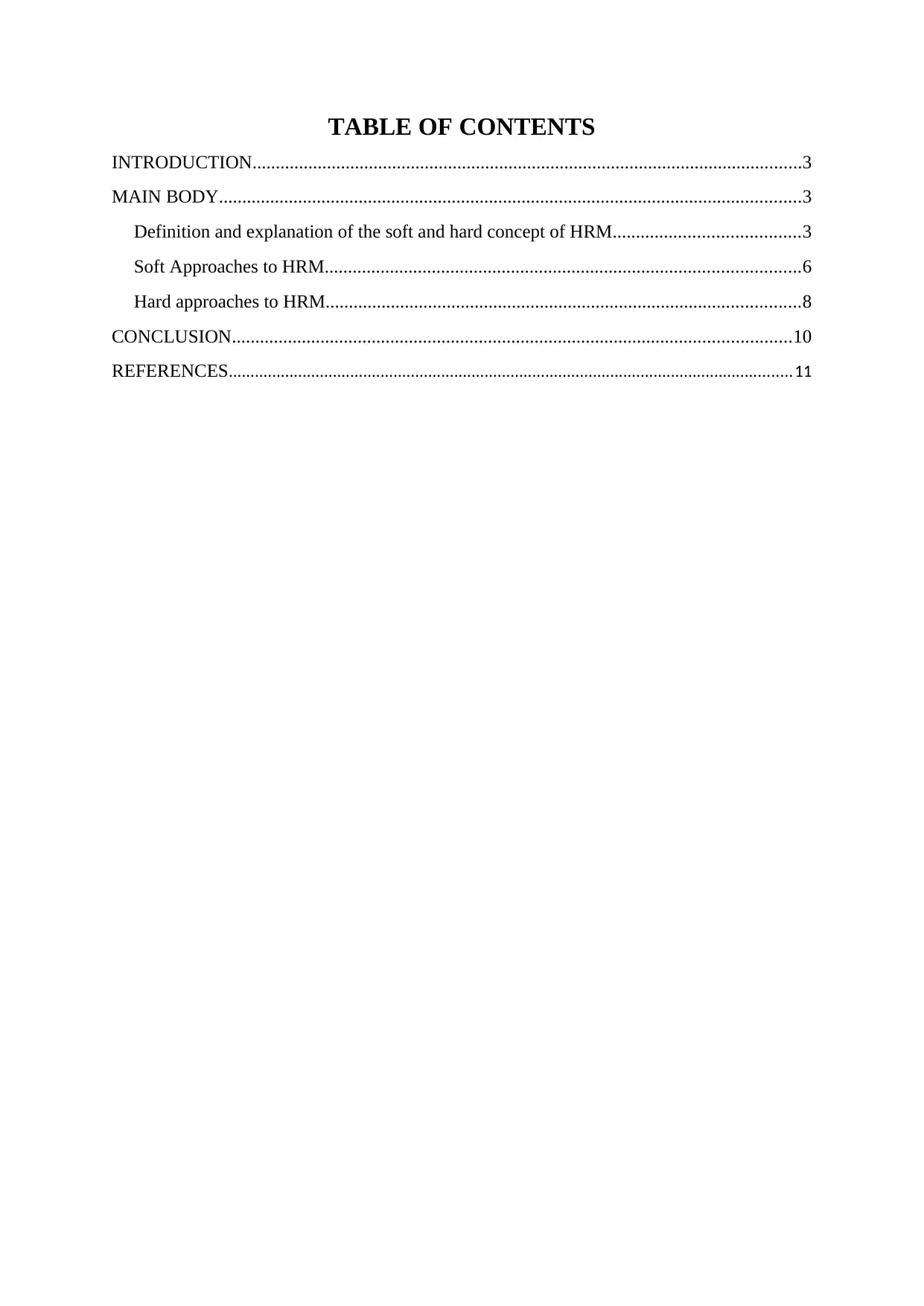
TABLE OF CONTENTS
INTRODUCTION......................................................................................................................3
MAIN BODY.............................................................................................................................3
Definition and explanation of the soft and hard concept of HRM........................................3
Soft Approaches to HRM......................................................................................................6
Hard approaches to HRM......................................................................................................8
CONCLUSION........................................................................................................................10
REFERENCES..................................................................................................................................11
INTRODUCTION......................................................................................................................3
MAIN BODY.............................................................................................................................3
Definition and explanation of the soft and hard concept of HRM........................................3
Soft Approaches to HRM......................................................................................................6
Hard approaches to HRM......................................................................................................8
CONCLUSION........................................................................................................................10
REFERENCES..................................................................................................................................11
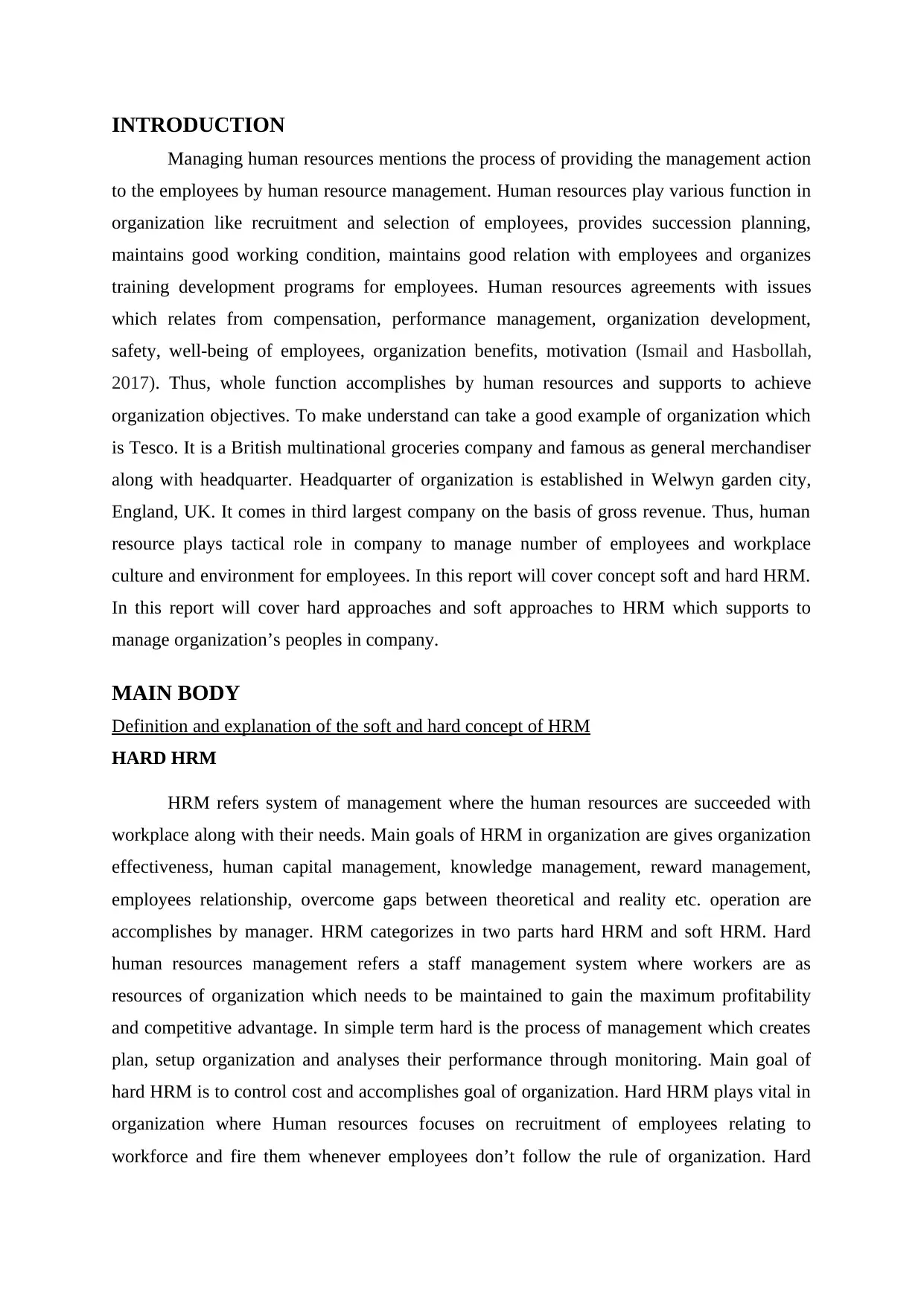
INTRODUCTION
Managing human resources mentions the process of providing the management action
to the employees by human resource management. Human resources play various function in
organization like recruitment and selection of employees, provides succession planning,
maintains good working condition, maintains good relation with employees and organizes
training development programs for employees. Human resources agreements with issues
which relates from compensation, performance management, organization development,
safety, well-being of employees, organization benefits, motivation (Ismail and Hasbollah,
2017). Thus, whole function accomplishes by human resources and supports to achieve
organization objectives. To make understand can take a good example of organization which
is Tesco. It is a British multinational groceries company and famous as general merchandiser
along with headquarter. Headquarter of organization is established in Welwyn garden city,
England, UK. It comes in third largest company on the basis of gross revenue. Thus, human
resource plays tactical role in company to manage number of employees and workplace
culture and environment for employees. In this report will cover concept soft and hard HRM.
In this report will cover hard approaches and soft approaches to HRM which supports to
manage organization’s peoples in company.
MAIN BODY
Definition and explanation of the soft and hard concept of HRM
HARD HRM
HRM refers system of management where the human resources are succeeded with
workplace along with their needs. Main goals of HRM in organization are gives organization
effectiveness, human capital management, knowledge management, reward management,
employees relationship, overcome gaps between theoretical and reality etc. operation are
accomplishes by manager. HRM categorizes in two parts hard HRM and soft HRM. Hard
human resources management refers a staff management system where workers are as
resources of organization which needs to be maintained to gain the maximum profitability
and competitive advantage. In simple term hard is the process of management which creates
plan, setup organization and analyses their performance through monitoring. Main goal of
hard HRM is to control cost and accomplishes goal of organization. Hard HRM plays vital in
organization where Human resources focuses on recruitment of employees relating to
workforce and fire them whenever employees don’t follow the rule of organization. Hard
Managing human resources mentions the process of providing the management action
to the employees by human resource management. Human resources play various function in
organization like recruitment and selection of employees, provides succession planning,
maintains good working condition, maintains good relation with employees and organizes
training development programs for employees. Human resources agreements with issues
which relates from compensation, performance management, organization development,
safety, well-being of employees, organization benefits, motivation (Ismail and Hasbollah,
2017). Thus, whole function accomplishes by human resources and supports to achieve
organization objectives. To make understand can take a good example of organization which
is Tesco. It is a British multinational groceries company and famous as general merchandiser
along with headquarter. Headquarter of organization is established in Welwyn garden city,
England, UK. It comes in third largest company on the basis of gross revenue. Thus, human
resource plays tactical role in company to manage number of employees and workplace
culture and environment for employees. In this report will cover concept soft and hard HRM.
In this report will cover hard approaches and soft approaches to HRM which supports to
manage organization’s peoples in company.
MAIN BODY
Definition and explanation of the soft and hard concept of HRM
HARD HRM
HRM refers system of management where the human resources are succeeded with
workplace along with their needs. Main goals of HRM in organization are gives organization
effectiveness, human capital management, knowledge management, reward management,
employees relationship, overcome gaps between theoretical and reality etc. operation are
accomplishes by manager. HRM categorizes in two parts hard HRM and soft HRM. Hard
human resources management refers a staff management system where workers are as
resources of organization which needs to be maintained to gain the maximum profitability
and competitive advantage. In simple term hard is the process of management which creates
plan, setup organization and analyses their performance through monitoring. Main goal of
hard HRM is to control cost and accomplishes goal of organization. Hard HRM plays vital in
organization where Human resources focuses on recruitment of employees relating to
workforce and fire them whenever employees don’t follow the rule of organization. Hard
⊘ This is a preview!⊘
Do you want full access?
Subscribe today to unlock all pages.

Trusted by 1+ million students worldwide
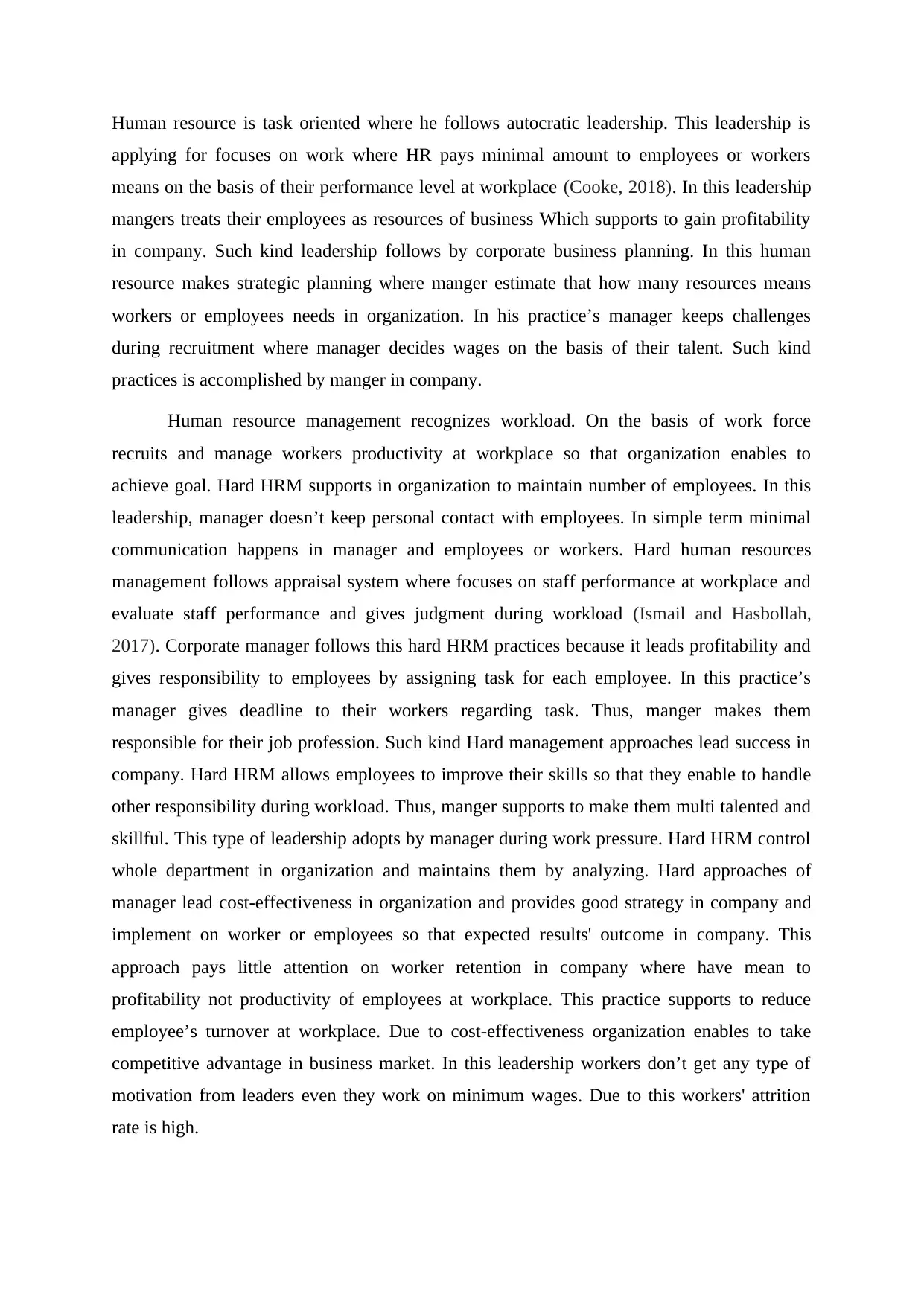
Human resource is task oriented where he follows autocratic leadership. This leadership is
applying for focuses on work where HR pays minimal amount to employees or workers
means on the basis of their performance level at workplace (Cooke, 2018). In this leadership
mangers treats their employees as resources of business Which supports to gain profitability
in company. Such kind leadership follows by corporate business planning. In this human
resource makes strategic planning where manger estimate that how many resources means
workers or employees needs in organization. In his practice’s manager keeps challenges
during recruitment where manager decides wages on the basis of their talent. Such kind
practices is accomplished by manger in company.
Human resource management recognizes workload. On the basis of work force
recruits and manage workers productivity at workplace so that organization enables to
achieve goal. Hard HRM supports in organization to maintain number of employees. In this
leadership, manager doesn’t keep personal contact with employees. In simple term minimal
communication happens in manager and employees or workers. Hard human resources
management follows appraisal system where focuses on staff performance at workplace and
evaluate staff performance and gives judgment during workload (Ismail and Hasbollah,
2017). Corporate manager follows this hard HRM practices because it leads profitability and
gives responsibility to employees by assigning task for each employee. In this practice’s
manager gives deadline to their workers regarding task. Thus, manger makes them
responsible for their job profession. Such kind Hard management approaches lead success in
company. Hard HRM allows employees to improve their skills so that they enable to handle
other responsibility during workload. Thus, manger supports to make them multi talented and
skillful. This type of leadership adopts by manager during work pressure. Hard HRM control
whole department in organization and maintains them by analyzing. Hard approaches of
manager lead cost-effectiveness in organization and provides good strategy in company and
implement on worker or employees so that expected results' outcome in company. This
approach pays little attention on worker retention in company where have mean to
profitability not productivity of employees at workplace. This practice supports to reduce
employee’s turnover at workplace. Due to cost-effectiveness organization enables to take
competitive advantage in business market. In this leadership workers don’t get any type of
motivation from leaders even they work on minimum wages. Due to this workers' attrition
rate is high.
applying for focuses on work where HR pays minimal amount to employees or workers
means on the basis of their performance level at workplace (Cooke, 2018). In this leadership
mangers treats their employees as resources of business Which supports to gain profitability
in company. Such kind leadership follows by corporate business planning. In this human
resource makes strategic planning where manger estimate that how many resources means
workers or employees needs in organization. In his practice’s manager keeps challenges
during recruitment where manager decides wages on the basis of their talent. Such kind
practices is accomplished by manger in company.
Human resource management recognizes workload. On the basis of work force
recruits and manage workers productivity at workplace so that organization enables to
achieve goal. Hard HRM supports in organization to maintain number of employees. In this
leadership, manager doesn’t keep personal contact with employees. In simple term minimal
communication happens in manager and employees or workers. Hard human resources
management follows appraisal system where focuses on staff performance at workplace and
evaluate staff performance and gives judgment during workload (Ismail and Hasbollah,
2017). Corporate manager follows this hard HRM practices because it leads profitability and
gives responsibility to employees by assigning task for each employee. In this practice’s
manager gives deadline to their workers regarding task. Thus, manger makes them
responsible for their job profession. Such kind Hard management approaches lead success in
company. Hard HRM allows employees to improve their skills so that they enable to handle
other responsibility during workload. Thus, manger supports to make them multi talented and
skillful. This type of leadership adopts by manager during work pressure. Hard HRM control
whole department in organization and maintains them by analyzing. Hard approaches of
manager lead cost-effectiveness in organization and provides good strategy in company and
implement on worker or employees so that expected results' outcome in company. This
approach pays little attention on worker retention in company where have mean to
profitability not productivity of employees at workplace. This practice supports to reduce
employee’s turnover at workplace. Due to cost-effectiveness organization enables to take
competitive advantage in business market. In this leadership workers don’t get any type of
motivation from leaders even they work on minimum wages. Due to this workers' attrition
rate is high.
Paraphrase This Document
Need a fresh take? Get an instant paraphrase of this document with our AI Paraphraser
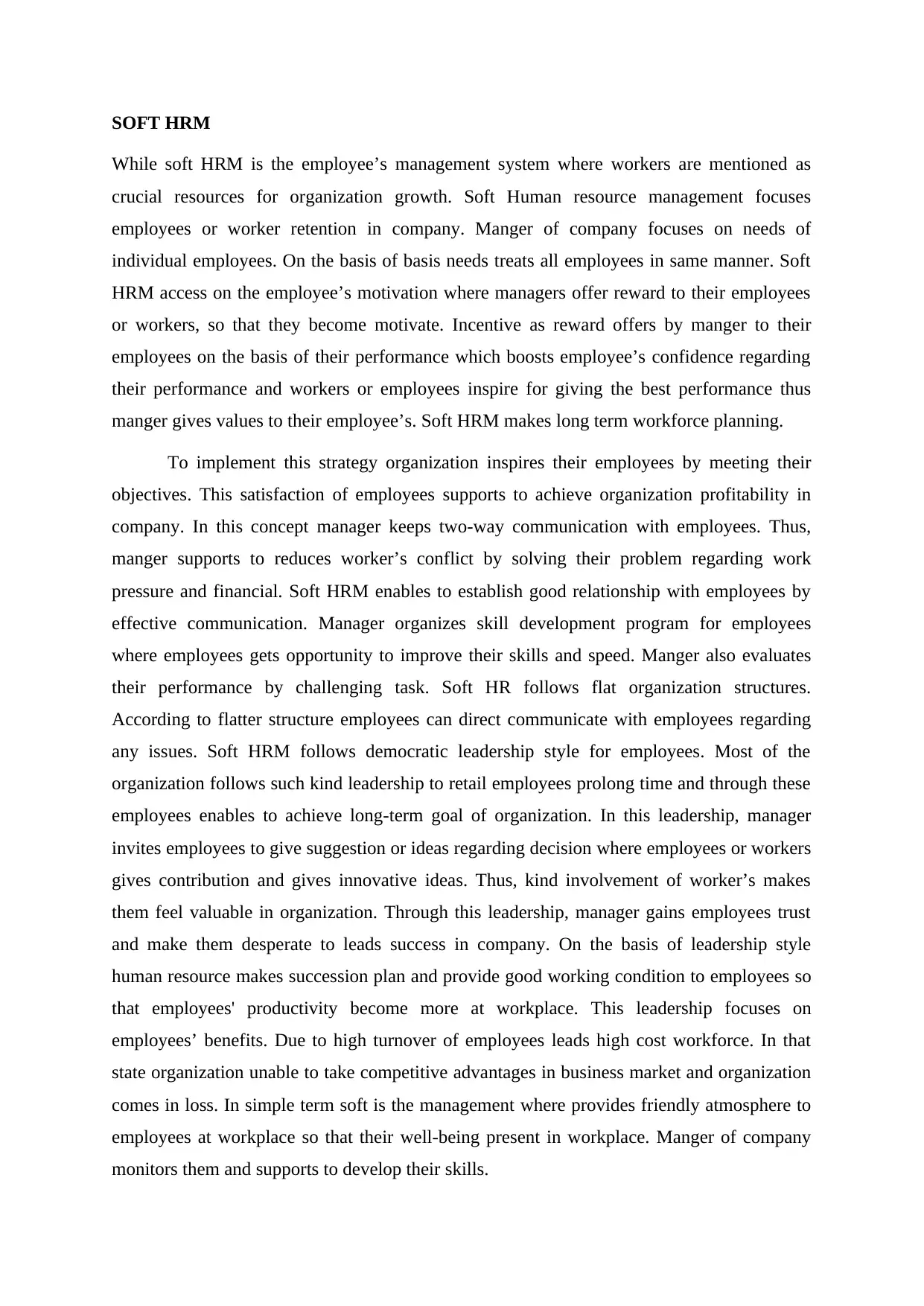
SOFT HRM
While soft HRM is the employee’s management system where workers are mentioned as
crucial resources for organization growth. Soft Human resource management focuses
employees or worker retention in company. Manger of company focuses on needs of
individual employees. On the basis of basis needs treats all employees in same manner. Soft
HRM access on the employee’s motivation where managers offer reward to their employees
or workers, so that they become motivate. Incentive as reward offers by manger to their
employees on the basis of their performance which boosts employee’s confidence regarding
their performance and workers or employees inspire for giving the best performance thus
manger gives values to their employee’s. Soft HRM makes long term workforce planning.
To implement this strategy organization inspires their employees by meeting their
objectives. This satisfaction of employees supports to achieve organization profitability in
company. In this concept manager keeps two-way communication with employees. Thus,
manger supports to reduces worker’s conflict by solving their problem regarding work
pressure and financial. Soft HRM enables to establish good relationship with employees by
effective communication. Manager organizes skill development program for employees
where employees gets opportunity to improve their skills and speed. Manger also evaluates
their performance by challenging task. Soft HR follows flat organization structures.
According to flatter structure employees can direct communicate with employees regarding
any issues. Soft HRM follows democratic leadership style for employees. Most of the
organization follows such kind leadership to retail employees prolong time and through these
employees enables to achieve long-term goal of organization. In this leadership, manager
invites employees to give suggestion or ideas regarding decision where employees or workers
gives contribution and gives innovative ideas. Thus, kind involvement of worker’s makes
them feel valuable in organization. Through this leadership, manager gains employees trust
and make them desperate to leads success in company. On the basis of leadership style
human resource makes succession plan and provide good working condition to employees so
that employees' productivity become more at workplace. This leadership focuses on
employees’ benefits. Due to high turnover of employees leads high cost workforce. In that
state organization unable to take competitive advantages in business market and organization
comes in loss. In simple term soft is the management where provides friendly atmosphere to
employees at workplace so that their well-being present in workplace. Manger of company
monitors them and supports to develop their skills.
While soft HRM is the employee’s management system where workers are mentioned as
crucial resources for organization growth. Soft Human resource management focuses
employees or worker retention in company. Manger of company focuses on needs of
individual employees. On the basis of basis needs treats all employees in same manner. Soft
HRM access on the employee’s motivation where managers offer reward to their employees
or workers, so that they become motivate. Incentive as reward offers by manger to their
employees on the basis of their performance which boosts employee’s confidence regarding
their performance and workers or employees inspire for giving the best performance thus
manger gives values to their employee’s. Soft HRM makes long term workforce planning.
To implement this strategy organization inspires their employees by meeting their
objectives. This satisfaction of employees supports to achieve organization profitability in
company. In this concept manager keeps two-way communication with employees. Thus,
manger supports to reduces worker’s conflict by solving their problem regarding work
pressure and financial. Soft HRM enables to establish good relationship with employees by
effective communication. Manager organizes skill development program for employees
where employees gets opportunity to improve their skills and speed. Manger also evaluates
their performance by challenging task. Soft HR follows flat organization structures.
According to flatter structure employees can direct communicate with employees regarding
any issues. Soft HRM follows democratic leadership style for employees. Most of the
organization follows such kind leadership to retail employees prolong time and through these
employees enables to achieve long-term goal of organization. In this leadership, manager
invites employees to give suggestion or ideas regarding decision where employees or workers
gives contribution and gives innovative ideas. Thus, kind involvement of worker’s makes
them feel valuable in organization. Through this leadership, manager gains employees trust
and make them desperate to leads success in company. On the basis of leadership style
human resource makes succession plan and provide good working condition to employees so
that employees' productivity become more at workplace. This leadership focuses on
employees’ benefits. Due to high turnover of employees leads high cost workforce. In that
state organization unable to take competitive advantages in business market and organization
comes in loss. In simple term soft is the management where provides friendly atmosphere to
employees at workplace so that their well-being present in workplace. Manger of company
monitors them and supports to develop their skills.
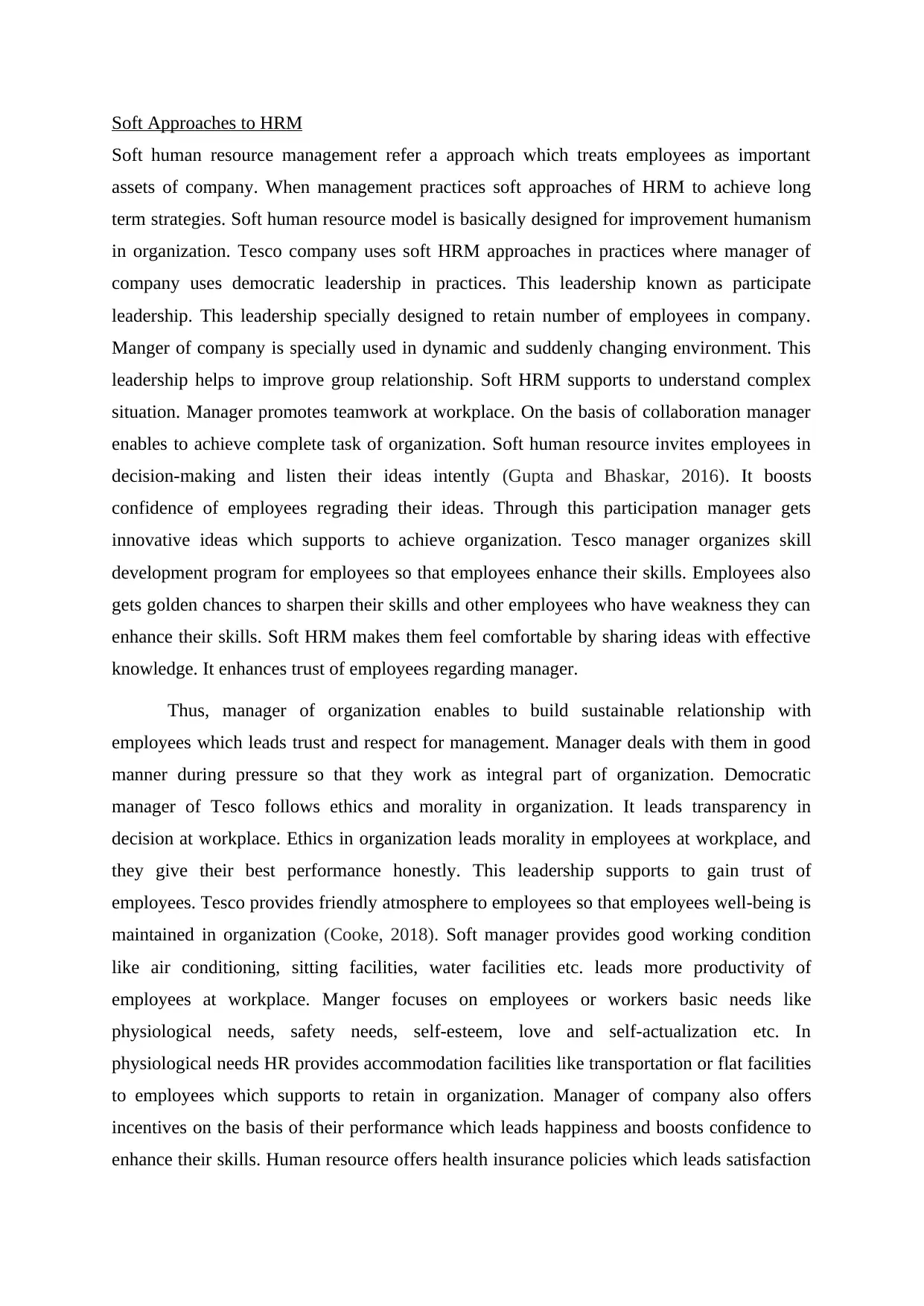
Soft Approaches to HRM
Soft human resource management refer a approach which treats employees as important
assets of company. When management practices soft approaches of HRM to achieve long
term strategies. Soft human resource model is basically designed for improvement humanism
in organization. Tesco company uses soft HRM approaches in practices where manager of
company uses democratic leadership in practices. This leadership known as participate
leadership. This leadership specially designed to retain number of employees in company.
Manger of company is specially used in dynamic and suddenly changing environment. This
leadership helps to improve group relationship. Soft HRM supports to understand complex
situation. Manager promotes teamwork at workplace. On the basis of collaboration manager
enables to achieve complete task of organization. Soft human resource invites employees in
decision-making and listen their ideas intently (Gupta and Bhaskar, 2016). It boosts
confidence of employees regrading their ideas. Through this participation manager gets
innovative ideas which supports to achieve organization. Tesco manager organizes skill
development program for employees so that employees enhance their skills. Employees also
gets golden chances to sharpen their skills and other employees who have weakness they can
enhance their skills. Soft HRM makes them feel comfortable by sharing ideas with effective
knowledge. It enhances trust of employees regarding manager.
Thus, manager of organization enables to build sustainable relationship with
employees which leads trust and respect for management. Manager deals with them in good
manner during pressure so that they work as integral part of organization. Democratic
manager of Tesco follows ethics and morality in organization. It leads transparency in
decision at workplace. Ethics in organization leads morality in employees at workplace, and
they give their best performance honestly. This leadership supports to gain trust of
employees. Tesco provides friendly atmosphere to employees so that employees well-being is
maintained in organization (Cooke, 2018). Soft manager provides good working condition
like air conditioning, sitting facilities, water facilities etc. leads more productivity of
employees at workplace. Manger focuses on employees or workers basic needs like
physiological needs, safety needs, self-esteem, love and self-actualization etc. In
physiological needs HR provides accommodation facilities like transportation or flat facilities
to employees which supports to retain in organization. Manager of company also offers
incentives on the basis of their performance which leads happiness and boosts confidence to
enhance their skills. Human resource offers health insurance policies which leads satisfaction
Soft human resource management refer a approach which treats employees as important
assets of company. When management practices soft approaches of HRM to achieve long
term strategies. Soft human resource model is basically designed for improvement humanism
in organization. Tesco company uses soft HRM approaches in practices where manager of
company uses democratic leadership in practices. This leadership known as participate
leadership. This leadership specially designed to retain number of employees in company.
Manger of company is specially used in dynamic and suddenly changing environment. This
leadership helps to improve group relationship. Soft HRM supports to understand complex
situation. Manager promotes teamwork at workplace. On the basis of collaboration manager
enables to achieve complete task of organization. Soft human resource invites employees in
decision-making and listen their ideas intently (Gupta and Bhaskar, 2016). It boosts
confidence of employees regrading their ideas. Through this participation manager gets
innovative ideas which supports to achieve organization. Tesco manager organizes skill
development program for employees so that employees enhance their skills. Employees also
gets golden chances to sharpen their skills and other employees who have weakness they can
enhance their skills. Soft HRM makes them feel comfortable by sharing ideas with effective
knowledge. It enhances trust of employees regarding manager.
Thus, manager of organization enables to build sustainable relationship with
employees which leads trust and respect for management. Manager deals with them in good
manner during pressure so that they work as integral part of organization. Democratic
manager of Tesco follows ethics and morality in organization. It leads transparency in
decision at workplace. Ethics in organization leads morality in employees at workplace, and
they give their best performance honestly. This leadership supports to gain trust of
employees. Tesco provides friendly atmosphere to employees so that employees well-being is
maintained in organization (Cooke, 2018). Soft manager provides good working condition
like air conditioning, sitting facilities, water facilities etc. leads more productivity of
employees at workplace. Manger focuses on employees or workers basic needs like
physiological needs, safety needs, self-esteem, love and self-actualization etc. In
physiological needs HR provides accommodation facilities like transportation or flat facilities
to employees which supports to retain in organization. Manager of company also offers
incentives on the basis of their performance which leads happiness and boosts confidence to
enhance their skills. Human resource offers health insurance policies which leads satisfaction
⊘ This is a preview!⊘
Do you want full access?
Subscribe today to unlock all pages.

Trusted by 1+ million students worldwide
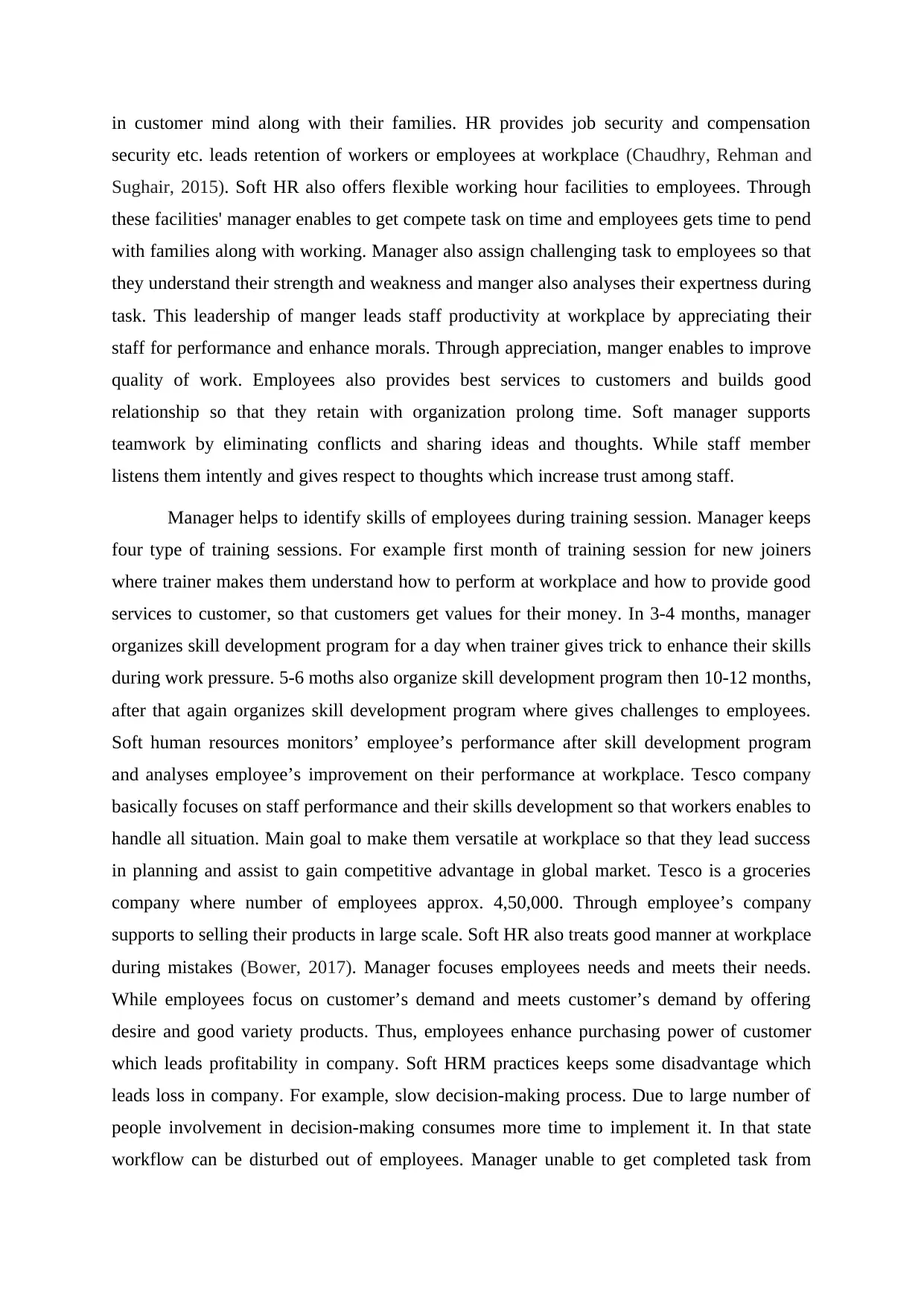
in customer mind along with their families. HR provides job security and compensation
security etc. leads retention of workers or employees at workplace (Chaudhry, Rehman and
Sughair, 2015). Soft HR also offers flexible working hour facilities to employees. Through
these facilities' manager enables to get compete task on time and employees gets time to pend
with families along with working. Manager also assign challenging task to employees so that
they understand their strength and weakness and manger also analyses their expertness during
task. This leadership of manger leads staff productivity at workplace by appreciating their
staff for performance and enhance morals. Through appreciation, manger enables to improve
quality of work. Employees also provides best services to customers and builds good
relationship so that they retain with organization prolong time. Soft manager supports
teamwork by eliminating conflicts and sharing ideas and thoughts. While staff member
listens them intently and gives respect to thoughts which increase trust among staff.
Manager helps to identify skills of employees during training session. Manager keeps
four type of training sessions. For example first month of training session for new joiners
where trainer makes them understand how to perform at workplace and how to provide good
services to customer, so that customers get values for their money. In 3-4 months, manager
organizes skill development program for a day when trainer gives trick to enhance their skills
during work pressure. 5-6 moths also organize skill development program then 10-12 months,
after that again organizes skill development program where gives challenges to employees.
Soft human resources monitors’ employee’s performance after skill development program
and analyses employee’s improvement on their performance at workplace. Tesco company
basically focuses on staff performance and their skills development so that workers enables to
handle all situation. Main goal to make them versatile at workplace so that they lead success
in planning and assist to gain competitive advantage in global market. Tesco is a groceries
company where number of employees approx. 4,50,000. Through employee’s company
supports to selling their products in large scale. Soft HR also treats good manner at workplace
during mistakes (Bower, 2017). Manager focuses employees needs and meets their needs.
While employees focus on customer’s demand and meets customer’s demand by offering
desire and good variety products. Thus, employees enhance purchasing power of customer
which leads profitability in company. Soft HRM practices keeps some disadvantage which
leads loss in company. For example, slow decision-making process. Due to large number of
people involvement in decision-making consumes more time to implement it. In that state
workflow can be disturbed out of employees. Manager unable to get completed task from
security etc. leads retention of workers or employees at workplace (Chaudhry, Rehman and
Sughair, 2015). Soft HR also offers flexible working hour facilities to employees. Through
these facilities' manager enables to get compete task on time and employees gets time to pend
with families along with working. Manager also assign challenging task to employees so that
they understand their strength and weakness and manger also analyses their expertness during
task. This leadership of manger leads staff productivity at workplace by appreciating their
staff for performance and enhance morals. Through appreciation, manger enables to improve
quality of work. Employees also provides best services to customers and builds good
relationship so that they retain with organization prolong time. Soft manager supports
teamwork by eliminating conflicts and sharing ideas and thoughts. While staff member
listens them intently and gives respect to thoughts which increase trust among staff.
Manager helps to identify skills of employees during training session. Manager keeps
four type of training sessions. For example first month of training session for new joiners
where trainer makes them understand how to perform at workplace and how to provide good
services to customer, so that customers get values for their money. In 3-4 months, manager
organizes skill development program for a day when trainer gives trick to enhance their skills
during work pressure. 5-6 moths also organize skill development program then 10-12 months,
after that again organizes skill development program where gives challenges to employees.
Soft human resources monitors’ employee’s performance after skill development program
and analyses employee’s improvement on their performance at workplace. Tesco company
basically focuses on staff performance and their skills development so that workers enables to
handle all situation. Main goal to make them versatile at workplace so that they lead success
in planning and assist to gain competitive advantage in global market. Tesco is a groceries
company where number of employees approx. 4,50,000. Through employee’s company
supports to selling their products in large scale. Soft HR also treats good manner at workplace
during mistakes (Bower, 2017). Manager focuses employees needs and meets their needs.
While employees focus on customer’s demand and meets customer’s demand by offering
desire and good variety products. Thus, employees enhance purchasing power of customer
which leads profitability in company. Soft HRM practices keeps some disadvantage which
leads loss in company. For example, slow decision-making process. Due to large number of
people involvement in decision-making consumes more time to implement it. In that state
workflow can be disturbed out of employees. Manager unable to get completed task from
Paraphrase This Document
Need a fresh take? Get an instant paraphrase of this document with our AI Paraphraser
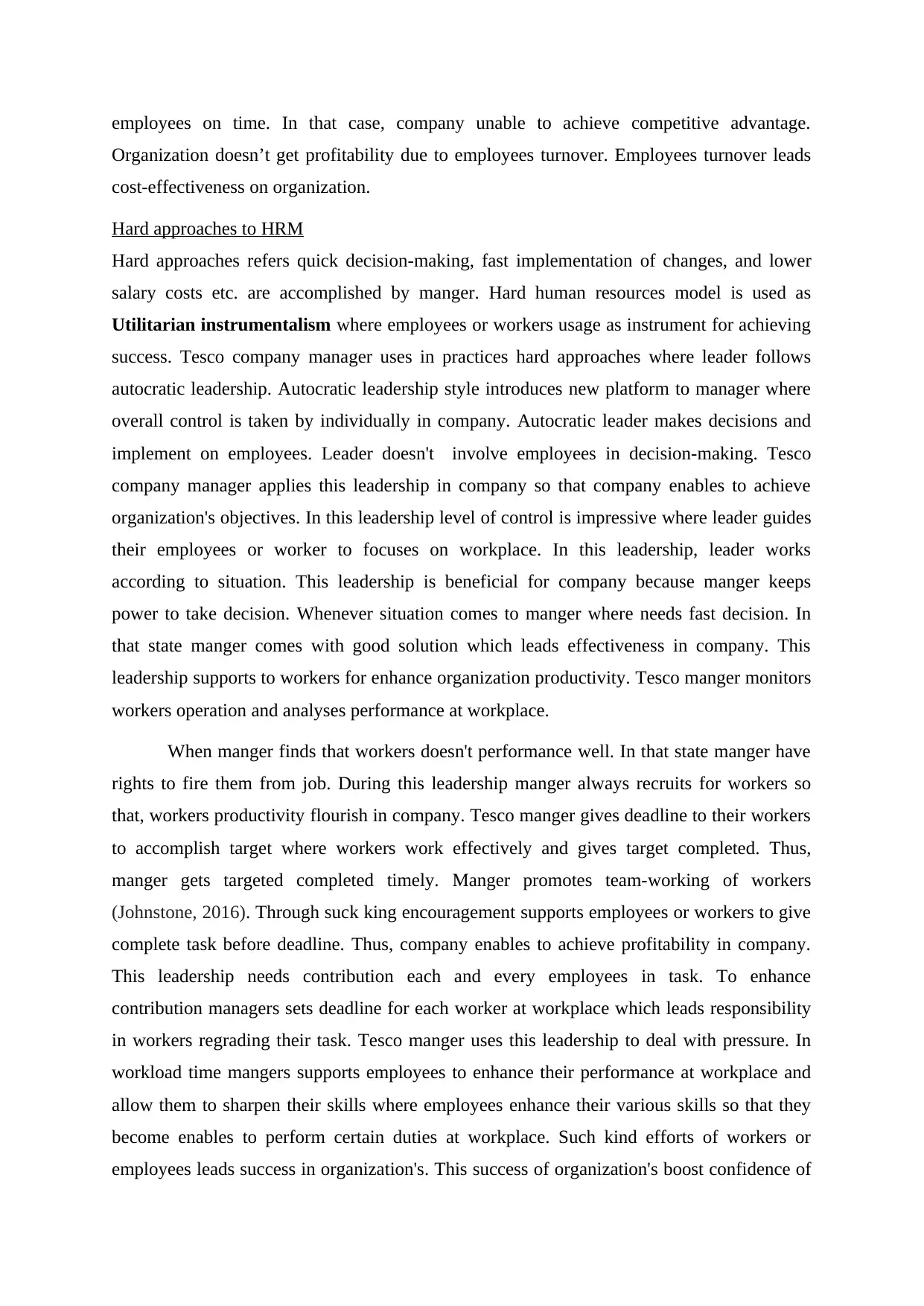
employees on time. In that case, company unable to achieve competitive advantage.
Organization doesn’t get profitability due to employees turnover. Employees turnover leads
cost-effectiveness on organization.
Hard approaches to HRM
Hard approaches refers quick decision-making, fast implementation of changes, and lower
salary costs etc. are accomplished by manger. Hard human resources model is used as
Utilitarian instrumentalism where employees or workers usage as instrument for achieving
success. Tesco company manager uses in practices hard approaches where leader follows
autocratic leadership. Autocratic leadership style introduces new platform to manager where
overall control is taken by individually in company. Autocratic leader makes decisions and
implement on employees. Leader doesn't involve employees in decision-making. Tesco
company manager applies this leadership in company so that company enables to achieve
organization's objectives. In this leadership level of control is impressive where leader guides
their employees or worker to focuses on workplace. In this leadership, leader works
according to situation. This leadership is beneficial for company because manger keeps
power to take decision. Whenever situation comes to manger where needs fast decision. In
that state manger comes with good solution which leads effectiveness in company. This
leadership supports to workers for enhance organization productivity. Tesco manger monitors
workers operation and analyses performance at workplace.
When manger finds that workers doesn't performance well. In that state manger have
rights to fire them from job. During this leadership manger always recruits for workers so
that, workers productivity flourish in company. Tesco manger gives deadline to their workers
to accomplish target where workers work effectively and gives target completed. Thus,
manger gets targeted completed timely. Manger promotes team-working of workers
(Johnstone, 2016). Through suck king encouragement supports employees or workers to give
complete task before deadline. Thus, company enables to achieve profitability in company.
This leadership needs contribution each and every employees in task. To enhance
contribution managers sets deadline for each worker at workplace which leads responsibility
in workers regrading their task. Tesco manger uses this leadership to deal with pressure. In
workload time mangers supports employees to enhance their performance at workplace and
allow them to sharpen their skills where employees enhance their various skills so that they
become enables to perform certain duties at workplace. Such kind efforts of workers or
employees leads success in organization's. This success of organization's boost confidence of
Organization doesn’t get profitability due to employees turnover. Employees turnover leads
cost-effectiveness on organization.
Hard approaches to HRM
Hard approaches refers quick decision-making, fast implementation of changes, and lower
salary costs etc. are accomplished by manger. Hard human resources model is used as
Utilitarian instrumentalism where employees or workers usage as instrument for achieving
success. Tesco company manager uses in practices hard approaches where leader follows
autocratic leadership. Autocratic leadership style introduces new platform to manager where
overall control is taken by individually in company. Autocratic leader makes decisions and
implement on employees. Leader doesn't involve employees in decision-making. Tesco
company manager applies this leadership in company so that company enables to achieve
organization's objectives. In this leadership level of control is impressive where leader guides
their employees or worker to focuses on workplace. In this leadership, leader works
according to situation. This leadership is beneficial for company because manger keeps
power to take decision. Whenever situation comes to manger where needs fast decision. In
that state manger comes with good solution which leads effectiveness in company. This
leadership supports to workers for enhance organization productivity. Tesco manger monitors
workers operation and analyses performance at workplace.
When manger finds that workers doesn't performance well. In that state manger have
rights to fire them from job. During this leadership manger always recruits for workers so
that, workers productivity flourish in company. Tesco manger gives deadline to their workers
to accomplish target where workers work effectively and gives target completed. Thus,
manger gets targeted completed timely. Manger promotes team-working of workers
(Johnstone, 2016). Through suck king encouragement supports employees or workers to give
complete task before deadline. Thus, company enables to achieve profitability in company.
This leadership needs contribution each and every employees in task. To enhance
contribution managers sets deadline for each worker at workplace which leads responsibility
in workers regrading their task. Tesco manger uses this leadership to deal with pressure. In
workload time mangers supports employees to enhance their performance at workplace and
allow them to sharpen their skills where employees enhance their various skills so that they
become enables to perform certain duties at workplace. Such kind efforts of workers or
employees leads success in organization's. This success of organization's boost confidence of
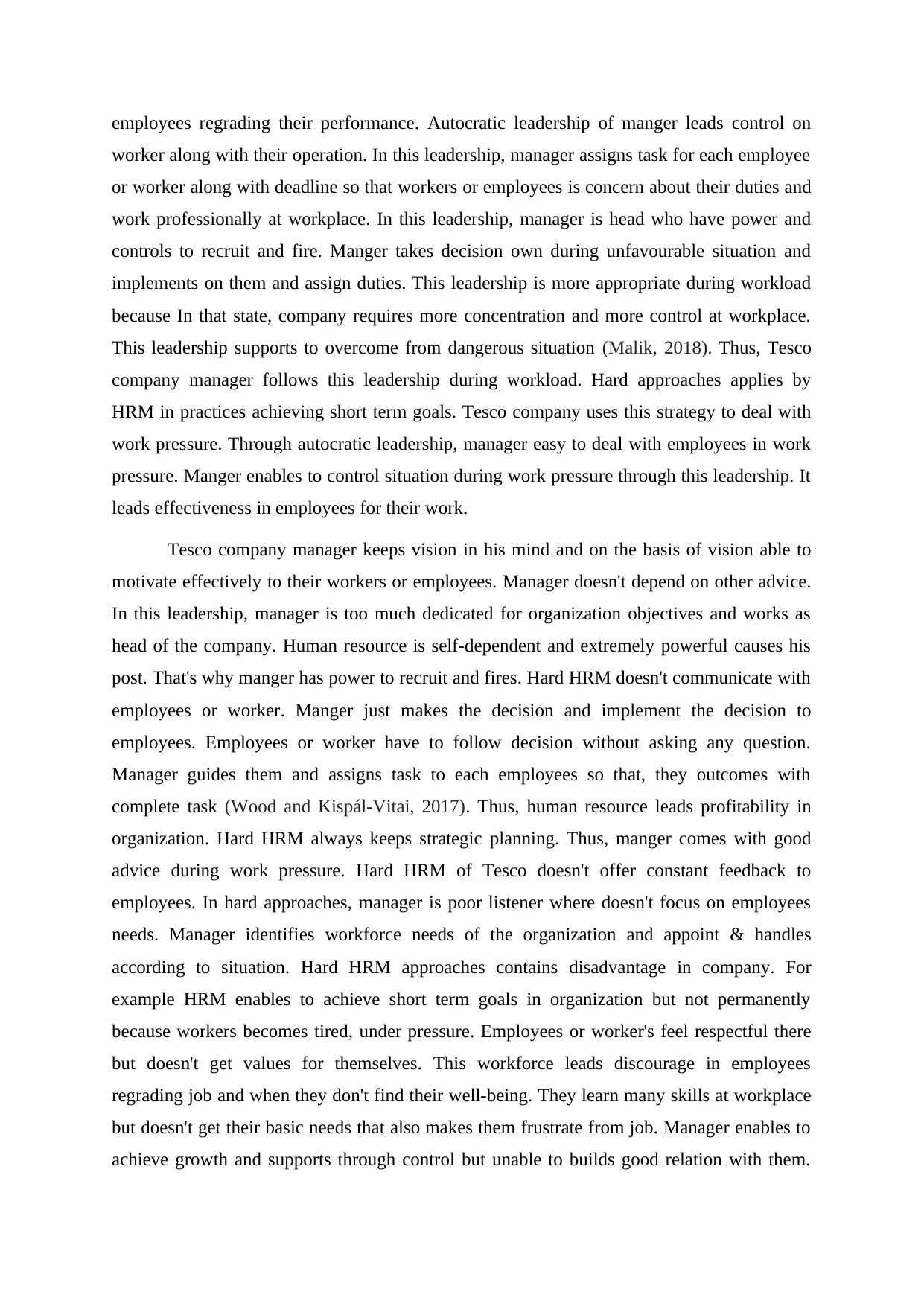
employees regrading their performance. Autocratic leadership of manger leads control on
worker along with their operation. In this leadership, manager assigns task for each employee
or worker along with deadline so that workers or employees is concern about their duties and
work professionally at workplace. In this leadership, manager is head who have power and
controls to recruit and fire. Manger takes decision own during unfavourable situation and
implements on them and assign duties. This leadership is more appropriate during workload
because In that state, company requires more concentration and more control at workplace.
This leadership supports to overcome from dangerous situation (Malik, 2018). Thus, Tesco
company manager follows this leadership during workload. Hard approaches applies by
HRM in practices achieving short term goals. Tesco company uses this strategy to deal with
work pressure. Through autocratic leadership, manager easy to deal with employees in work
pressure. Manger enables to control situation during work pressure through this leadership. It
leads effectiveness in employees for their work.
Tesco company manager keeps vision in his mind and on the basis of vision able to
motivate effectively to their workers or employees. Manager doesn't depend on other advice.
In this leadership, manager is too much dedicated for organization objectives and works as
head of the company. Human resource is self-dependent and extremely powerful causes his
post. That's why manger has power to recruit and fires. Hard HRM doesn't communicate with
employees or worker. Manger just makes the decision and implement the decision to
employees. Employees or worker have to follow decision without asking any question.
Manager guides them and assigns task to each employees so that, they outcomes with
complete task (Wood and Kispál-Vitai, 2017). Thus, human resource leads profitability in
organization. Hard HRM always keeps strategic planning. Thus, manger comes with good
advice during work pressure. Hard HRM of Tesco doesn't offer constant feedback to
employees. In hard approaches, manager is poor listener where doesn't focus on employees
needs. Manager identifies workforce needs of the organization and appoint & handles
according to situation. Hard HRM approaches contains disadvantage in company. For
example HRM enables to achieve short term goals in organization but not permanently
because workers becomes tired, under pressure. Employees or worker's feel respectful there
but doesn't get values for themselves. This workforce leads discourage in employees
regrading job and when they don't find their well-being. They learn many skills at workplace
but doesn't get their basic needs that also makes them frustrate from job. Manager enables to
achieve growth and supports through control but unable to builds good relation with them.
worker along with their operation. In this leadership, manager assigns task for each employee
or worker along with deadline so that workers or employees is concern about their duties and
work professionally at workplace. In this leadership, manager is head who have power and
controls to recruit and fire. Manger takes decision own during unfavourable situation and
implements on them and assign duties. This leadership is more appropriate during workload
because In that state, company requires more concentration and more control at workplace.
This leadership supports to overcome from dangerous situation (Malik, 2018). Thus, Tesco
company manager follows this leadership during workload. Hard approaches applies by
HRM in practices achieving short term goals. Tesco company uses this strategy to deal with
work pressure. Through autocratic leadership, manager easy to deal with employees in work
pressure. Manger enables to control situation during work pressure through this leadership. It
leads effectiveness in employees for their work.
Tesco company manager keeps vision in his mind and on the basis of vision able to
motivate effectively to their workers or employees. Manager doesn't depend on other advice.
In this leadership, manager is too much dedicated for organization objectives and works as
head of the company. Human resource is self-dependent and extremely powerful causes his
post. That's why manger has power to recruit and fires. Hard HRM doesn't communicate with
employees or worker. Manger just makes the decision and implement the decision to
employees. Employees or worker have to follow decision without asking any question.
Manager guides them and assigns task to each employees so that, they outcomes with
complete task (Wood and Kispál-Vitai, 2017). Thus, human resource leads profitability in
organization. Hard HRM always keeps strategic planning. Thus, manger comes with good
advice during work pressure. Hard HRM of Tesco doesn't offer constant feedback to
employees. In hard approaches, manager is poor listener where doesn't focus on employees
needs. Manager identifies workforce needs of the organization and appoint & handles
according to situation. Hard HRM approaches contains disadvantage in company. For
example HRM enables to achieve short term goals in organization but not permanently
because workers becomes tired, under pressure. Employees or worker's feel respectful there
but doesn't get values for themselves. This workforce leads discourage in employees
regrading job and when they don't find their well-being. They learn many skills at workplace
but doesn't get their basic needs that also makes them frustrate from job. Manager enables to
achieve growth and supports through control but unable to builds good relation with them.
⊘ This is a preview!⊘
Do you want full access?
Subscribe today to unlock all pages.

Trusted by 1+ million students worldwide
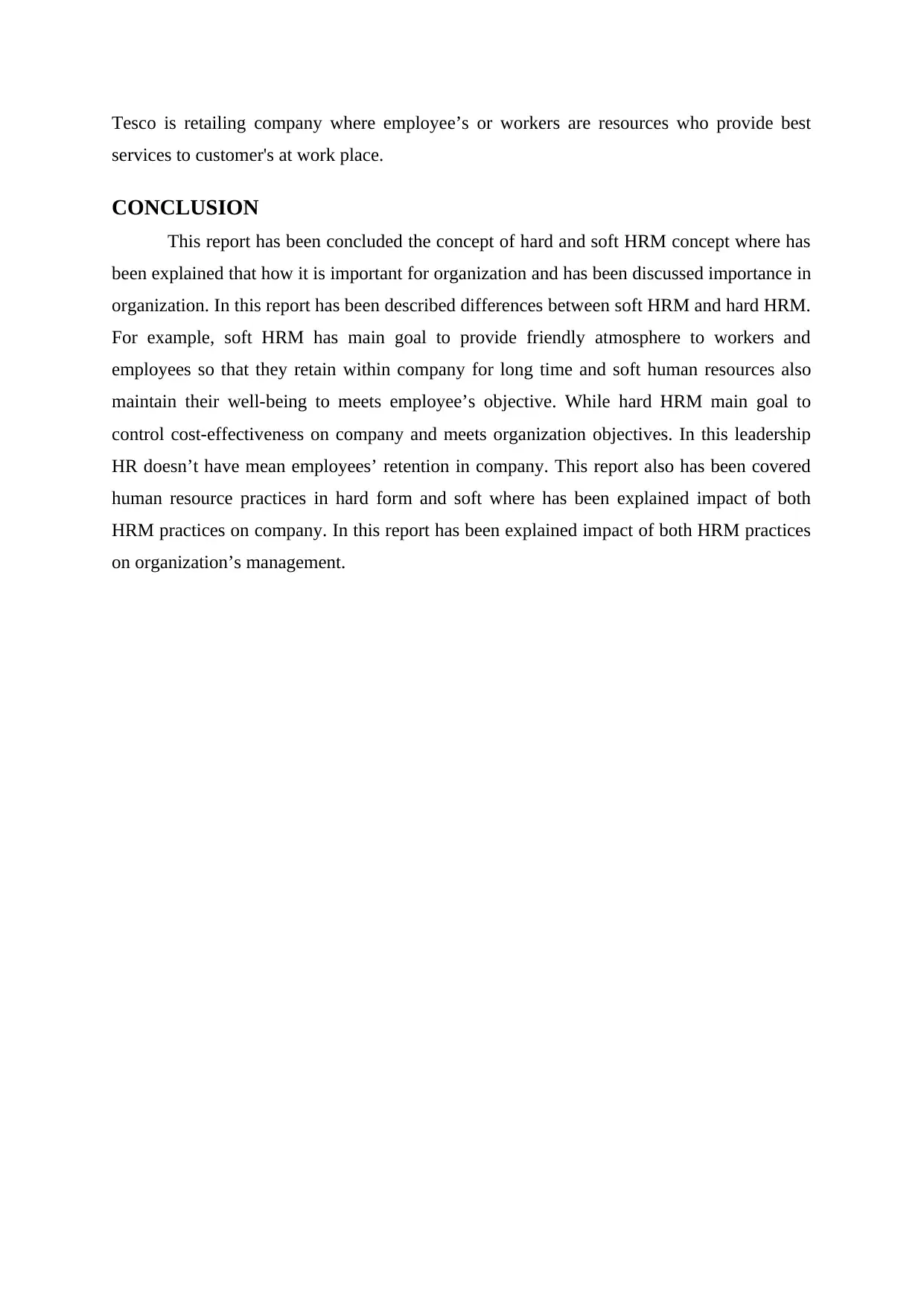
Tesco is retailing company where employee’s or workers are resources who provide best
services to customer's at work place.
CONCLUSION
This report has been concluded the concept of hard and soft HRM concept where has
been explained that how it is important for organization and has been discussed importance in
organization. In this report has been described differences between soft HRM and hard HRM.
For example, soft HRM has main goal to provide friendly atmosphere to workers and
employees so that they retain within company for long time and soft human resources also
maintain their well-being to meets employee’s objective. While hard HRM main goal to
control cost-effectiveness on company and meets organization objectives. In this leadership
HR doesn’t have mean employees’ retention in company. This report also has been covered
human resource practices in hard form and soft where has been explained impact of both
HRM practices on company. In this report has been explained impact of both HRM practices
on organization’s management.
services to customer's at work place.
CONCLUSION
This report has been concluded the concept of hard and soft HRM concept where has
been explained that how it is important for organization and has been discussed importance in
organization. In this report has been described differences between soft HRM and hard HRM.
For example, soft HRM has main goal to provide friendly atmosphere to workers and
employees so that they retain within company for long time and soft human resources also
maintain their well-being to meets employee’s objective. While hard HRM main goal to
control cost-effectiveness on company and meets organization objectives. In this leadership
HR doesn’t have mean employees’ retention in company. This report also has been covered
human resource practices in hard form and soft where has been explained impact of both
HRM practices on company. In this report has been explained impact of both HRM practices
on organization’s management.
Paraphrase This Document
Need a fresh take? Get an instant paraphrase of this document with our AI Paraphraser
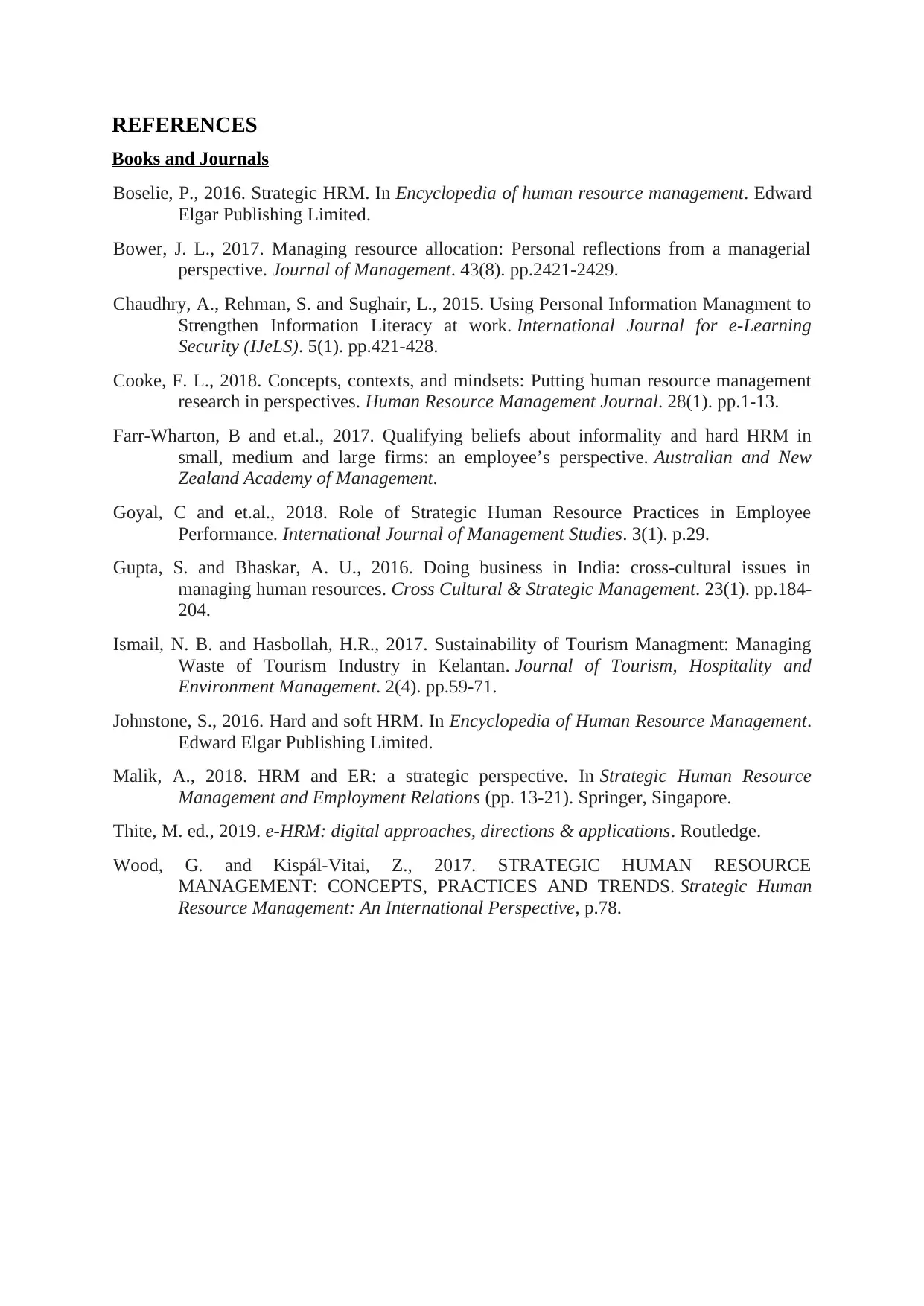
REFERENCES
Books and Journals
Boselie, P., 2016. Strategic HRM. In Encyclopedia of human resource management. Edward
Elgar Publishing Limited.
Bower, J. L., 2017. Managing resource allocation: Personal reflections from a managerial
perspective. Journal of Management. 43(8). pp.2421-2429.
Chaudhry, A., Rehman, S. and Sughair, L., 2015. Using Personal Information Managment to
Strengthen Information Literacy at work. International Journal for e-Learning
Security (IJeLS). 5(1). pp.421-428.
Cooke, F. L., 2018. Concepts, contexts, and mindsets: Putting human resource management
research in perspectives. Human Resource Management Journal. 28(1). pp.1-13.
Farr-Wharton, B and et.al., 2017. Qualifying beliefs about informality and hard HRM in
small, medium and large firms: an employee’s perspective. Australian and New
Zealand Academy of Management.
Goyal, C and et.al., 2018. Role of Strategic Human Resource Practices in Employee
Performance. International Journal of Management Studies. 3(1). p.29.
Gupta, S. and Bhaskar, A. U., 2016. Doing business in India: cross-cultural issues in
managing human resources. Cross Cultural & Strategic Management. 23(1). pp.184-
204.
Ismail, N. B. and Hasbollah, H.R., 2017. Sustainability of Tourism Managment: Managing
Waste of Tourism Industry in Kelantan. Journal of Tourism, Hospitality and
Environment Management. 2(4). pp.59-71.
Johnstone, S., 2016. Hard and soft HRM. In Encyclopedia of Human Resource Management.
Edward Elgar Publishing Limited.
Malik, A., 2018. HRM and ER: a strategic perspective. In Strategic Human Resource
Management and Employment Relations (pp. 13-21). Springer, Singapore.
Thite, M. ed., 2019. e-HRM: digital approaches, directions & applications. Routledge.
Wood, G. and Kispál-Vitai, Z., 2017. STRATEGIC HUMAN RESOURCE
MANAGEMENT: CONCEPTS, PRACTICES AND TRENDS. Strategic Human
Resource Management: An International Perspective, p.78.
Books and Journals
Boselie, P., 2016. Strategic HRM. In Encyclopedia of human resource management. Edward
Elgar Publishing Limited.
Bower, J. L., 2017. Managing resource allocation: Personal reflections from a managerial
perspective. Journal of Management. 43(8). pp.2421-2429.
Chaudhry, A., Rehman, S. and Sughair, L., 2015. Using Personal Information Managment to
Strengthen Information Literacy at work. International Journal for e-Learning
Security (IJeLS). 5(1). pp.421-428.
Cooke, F. L., 2018. Concepts, contexts, and mindsets: Putting human resource management
research in perspectives. Human Resource Management Journal. 28(1). pp.1-13.
Farr-Wharton, B and et.al., 2017. Qualifying beliefs about informality and hard HRM in
small, medium and large firms: an employee’s perspective. Australian and New
Zealand Academy of Management.
Goyal, C and et.al., 2018. Role of Strategic Human Resource Practices in Employee
Performance. International Journal of Management Studies. 3(1). p.29.
Gupta, S. and Bhaskar, A. U., 2016. Doing business in India: cross-cultural issues in
managing human resources. Cross Cultural & Strategic Management. 23(1). pp.184-
204.
Ismail, N. B. and Hasbollah, H.R., 2017. Sustainability of Tourism Managment: Managing
Waste of Tourism Industry in Kelantan. Journal of Tourism, Hospitality and
Environment Management. 2(4). pp.59-71.
Johnstone, S., 2016. Hard and soft HRM. In Encyclopedia of Human Resource Management.
Edward Elgar Publishing Limited.
Malik, A., 2018. HRM and ER: a strategic perspective. In Strategic Human Resource
Management and Employment Relations (pp. 13-21). Springer, Singapore.
Thite, M. ed., 2019. e-HRM: digital approaches, directions & applications. Routledge.
Wood, G. and Kispál-Vitai, Z., 2017. STRATEGIC HUMAN RESOURCE
MANAGEMENT: CONCEPTS, PRACTICES AND TRENDS. Strategic Human
Resource Management: An International Perspective, p.78.
1 out of 11
Related Documents
Your All-in-One AI-Powered Toolkit for Academic Success.
+13062052269
info@desklib.com
Available 24*7 on WhatsApp / Email
![[object Object]](/_next/static/media/star-bottom.7253800d.svg)
Unlock your academic potential
Copyright © 2020–2025 A2Z Services. All Rights Reserved. Developed and managed by ZUCOL.





